| Pages:
1
2
3
4
5 |
jdowning
Oud Junkie
    
Posts: 3485
Registered: 8-2-2006
Location: Ontario, Canada
Member Is Offline
Mood: No Mood
|
|
With the pre-soaking tests in progress, preparations for the second phase of this investigation - to make full sized fluted oud or lute ribs - have
gone ahead with the making of the molds. I plan to test both male and female type molds into which the softened rib blanks will be clamped and allowed
to re-harden.
The profile of an early 17th C lute has been used for the molds. Both molds were straightforward to make. The male mold version was made from a piece
of elm wood with the rib profile cut out and the curve of the flute cut using a rounding over bit in a router. The female mold was a little more
complicated as it has to be made in two halves. Two pine boards were screwed together and cut to the required rib profile using a bandsaw. After
smoothing the profile, the two halves were separated and the inside curve of the flute cut with a coving cutter using a router. The two halves were
then screwed back together - the screws providing perfect registration and fit of the parts.
In my haste to make the molds, I forgot to provide extra height to the profile of the female mold to allow for the depth of the flute so this mold is
smaller than it should have been. Not to worry, this is only a mold designed to test the feasibility of making fluted ribs. If it works using this
mold - the method will also work for larger or smaller molds.
Additional nails or screws will be fitted to the male mold to provide anchor points for the string windings that will be used to provide the clamping
force on the rib. The clamping force on the female mold will be provided with a rope or fabric tape under tension or using a series of shaped wooden
blocks clamped in place. The method that works best under test will be the one chosen.
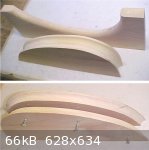
|
|
|
jdowning
Oud Junkie
    
Posts: 3485
Registered: 8-2-2006
Location: Ontario, Canada
Member Is Offline
Mood: No Mood
|
|
The rib blanks will be cut a little oversize to the required profile (to allow for final trimming) - ie tapering to a point at each end. This will be
necessary to minimise the stresses under tension generated along the outer edges of the rib when clamped in place. This is possible because the depth
of the flute diminishes from the centre of the rib to the extremities. Attempting to bend a parallel sided rib blank would be more likely to fail due
to the greater tensile stresses generated along the edges. If the methodology proves to be successful, most of the fluted shape will be achieved under
compressive stress loadings that the wood cells are able to tolerate much better than if subject to tensile loadings. At least, that is the theory -
the 'proof will be in the pudding'!
The images show rib blanks positioned on the molds as they would be prior to clamping in place following softening of seasoned wood (or when
'green').

|
|
|
jdowning
Oud Junkie
    
Posts: 3485
Registered: 8-2-2006
Location: Ontario, Canada
Member Is Offline
Mood: No Mood
|
|
As I have 'green' vinewood to hand that I know is very flexible it was decided to try to try to 'cold' bend a sample on the male mold. At the same
time, advantage was taken of the natural curvature in the vine stem selected. The stem was first cut longitudinally through the centre and then sliced
into curved strips, about 3 mm thick using a bandsaw and temporary wooden guide clamped to the bandsaw table.
The outermost strip was chosen for the test - this being slab sawn so that the grain would cause the strip to 'cup' in the direction of the flute
curavture on drying.
The strips were very flexible longitudinally and there was moisture (sap) visible on the cut surfaces.

|
|
|
jdowning
Oud Junkie
    
Posts: 3485
Registered: 8-2-2006
Location: Ontario, Canada
Member Is Offline
Mood: No Mood
|
|
The strip selected was so flexible that it could be flattened with the weight of a small plane. The top surface of the strip was, therefore, planed
smooth - this surface being in contact with the mold. The thickness of the strip was about 2mm after planing one side. The opposite side was left with
the sawn surface.
The strip was cut to the dimensions of a rib ready for clamping to the mold.
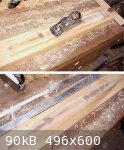
|
|
|
jdowning
Oud Junkie
    
Posts: 3485
Registered: 8-2-2006
Location: Ontario, Canada
Member Is Offline
Mood: No Mood
|
|
The rib was clamped to the mold using string wound tightly around the mold. A quick convenient method that applies a gradual increasing clamping force
as the string winding progresses. The rib blank readily conformed to the longitudinal curve of the mold but failed by cracking along the centre line
as loading was applied by the string. Clearly the combined transverse and longitudinal tensile stresses (with greatest stress along the centre line)
exceeded the tensile stress limit of the wood.
What can be learned from this failure? The vine rib blank was not clear and straight grained but contained knots and crooked grain. The cracking
initiated in the grain irregularities surrounding the knots. The rib blank measured 2.3 mm thick which is likely much too thick. The string winding
does not provide uniform support of the surfaces under tension. A series of metal (or woven fabric) bands for clamps might be a better arrangement for
providing even support.
For this procedure to have a chance of succeeding, a rib blank must be straight grained and free of flaws, thin (under 1.3 mm say), and be fully
supported during bending against tensile stress failure. It must also, of course be soft and flexible prior to bending.
It is uncertain at present if a blank should be quarter sawn or slab cut for best effect.
The initial pre-soaking trials of phase 1 of this investigation will be completed and reported on tomorrow.
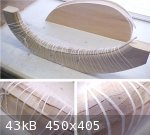
|
|
|
jdowning
Oud Junkie
    
Posts: 3485
Registered: 8-2-2006
Location: Ontario, Canada
Member Is Offline
Mood: No Mood
|
|
Pre-soaking/ Boiling Bending Tests.
Test samples were prepared from Black Walnut and Maple, each, quarter sawn, measuring about 35 mm wide by 135 mm long by less than 1.5 mm thick -
planed smooth on both sides. The Walnut was wood recovered from a 19th C reed organ so has been drying for about 100 to 150 years. The Maple has been
drying for at least 30 years - but probably a lot longer than that - so both species are well seasoned.
The saddle shaped wooden mold previously posted has been made to the same rib shape as the 16th C Dias vaulted back guitar i.e. with longitudinal
curve measuring 27 inches radius (686 mm) and a flute radius of 18 mm (less than 3/4 inch). After soaking in the chosen marinade for several days,
each sample was boiled in fresh water for 5 minutes before being quickly clamped to the mold by binding it with string. The string binding method is
very simple and applies a gradually increasing clamping force. The main purpose of boiling was to cleanse the wood pores of any residual marinade and
to heat the wood in order to accelerate drying of the sample in the mold - although some softening of the wood, due to boiling, probably occurred as
well.
Each sample was left to dry, clamped to the the mold, in a warm room (at about 20 C/ 65 F, relative humidity about 65%) for 24 hours. After being
released from the mold each sample was allowed to dry for a further 24 hours before being measured dimensionally.
The first test, as a 'benchmark', was to try to bend a sample - without any pre-soaking - simply by boiling it in fresh water for 5 minutes. This
Walnut sample failed by splitting down the centre well before the string winding could be completed and full pressure applied. The test was not
repeated using a Maple sample as boiling alone, to soften the wood, is clearly not going to be an effective procedure for these tests.
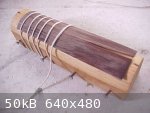
|
|
|
jdowning
Oud Junkie
    
Posts: 3485
Registered: 8-2-2006
Location: Ontario, Canada
Member Is Offline
Mood: No Mood
|
|
The marinating of the samples was accomplished by placing a Walnut and Maple sample, together, in a small 'Ziploc' type plastic bag with about 15 to
20 ml (cubic centimetres) of the chosen marinating fluid. The bag with samples was then sealed and left to stand in a cool room at 10 C/ 50 F.
The first samples to be tested were those marinated in Sake (Rice wine) for a period of 4/5 days. The attached images show that both samples were
successfully clamped to the profile of the mold after boiling. The Maple sample cracked at both ends - the cracks running for 25 mm and 15mm in length
respectively. I am not too concerned about the end cracking - which is due to intensified tensile stress at the free ends of the sample, stresses most
likely further amplified by the rough, sawn, edges - the saw cuts being 'stress raisers' or local points of high stress concentration. This fault may
be minimised in future full scale tests by ensuring that the ends of the rib blanks are cut smooth and by leaving extra length to the blank so that
such faults may be cut off.
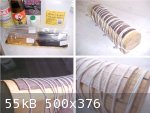
|
|
|
jdowning
Oud Junkie
    
Posts: 3485
Registered: 8-2-2006
Location: Ontario, Canada
Member Is Offline
Mood: No Mood
|
|
So far so good. The walnut sample after release from the mold retained the desired inverted saddle shape. The dried, bent sample measures about 1.1 mm
thick. The longitudinal radius has 'sprung' on drying from a radius of 27 inches to 34 inches (686 mm to 854 mm) and the flute inside radius is
maintained at 18 mm.
The thicker Maple sample at 1.3 mm thick also achieved a longitudinal radius of 34 inches but the inside radius of the flute opened up to 24 mm (about
15/16 inch). Not quite so good.
There are a few variables to take into account here, but thinner would seem to be better as far as three dimensional bending of the samples is
concerned - less tensile stress in bending.
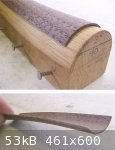
|
|
|
Clayton
Oud Maniac
   
Posts: 52
Registered: 10-24-2008
Location: On the ranch... California
Member Is Offline
Mood: Calm
|
|
Wow
Hi jdowning,
Just want to say a few words... about what interesting work you are doing.
I have not seen how it can be done to curve the wood on two axis, however, it must be possible because I have seen the resulting instruments and it
must be a relatively simple set up and process because it was done in shops in the 16-17th century... before sophisticated steam bending machines
etc... I have seen furniture done this way as well... fluted chair backs and fluted chest tops etc... Keep up the good work and good luck with your
progress.
Do you make or play lutes? I think I read one of your posts that mentioned that.
|
|
|
jdowning
Oud Junkie
    
Posts: 3485
Registered: 8-2-2006
Location: Ontario, Canada
Member Is Offline
Mood: No Mood
|
|
Thanks Clayton - we should be careful not to underestimate the technical skills of the luthiers (and other craftsmen/tradesmen) of the 16th C and
earlier. I suspect that more useful technology has been lost forever in the course of history - gone to the grave with the practitioners - than we
have remaining available to us today. The challenge is to try to rediscover what has been lost by a process of experimentation using materials and
methods that would have been available to those early craftsmen.
I don't believe that steaming the wood is the answer in this case - and I have no doubt that steam bending of wood (at atmospheric pressure) was a
technology practiced in earlier times. I believe that a simpler process was used - but not because steaming technology was not available.
I have been immersed in early music interests for over 30 years, both as a maker and player of early instruments, having made several lutes, vihuelas,
guitars etc. during that period - for my own use and research purposes. (see 'Old Project - New Lute' on this forum for example). However, I have many
other interests as well, particularly in the field of early technologies - but that's another story!
|
|
|
Josh
Oud Addict
  
Posts: 32
Registered: 10-7-2008
Location: UK
Member Is Offline
Mood: No Mood
|
|
it seems to me that some kind of pee is usually involved when making anything medieval 
|
|
|
patheslip
Oud Junkie
    
Posts: 160
Registered: 5-24-2008
Location: Welsh Marches
Member Is Offline
Mood: smooth
|
|
Josh is right, urea is used to soften lignin
|
|
|
jdowning
Oud Junkie
    
Posts: 3485
Registered: 8-2-2006
Location: Ontario, Canada
Member Is Offline
Mood: No Mood
|
|
Yes, it is used for chemical wood bending but apparently is not as effective as steam bending - and it is a component of urine.
Urine had an application in the past as a chemical used in dyeing wool and yarns - even for dyeing hair among some 'primitive' peoples. It was used
either fresh or fermented (i.e. 'stale'when the urea component converts to ammonia). I did give some thought to adding it to my list of marinades but
decided against it - for now at least. Besides determining the best urine for the job and from which animal would likely be a big investigation in
itself. It has the benefit of being much safer than some of the chemicals that I am already testing.
When checking out the urea question, I came across a traditional method for softening Coir fibre - fibre from coconut husks. The husks are 'ponded' -
immersed in ponds of brackish water for up to 12 months for anaerobic bacterial activity to do its work after which time the fibres become soft and
pliable. Sound familiar? As I now recall "retting" is (was) a process also used in preparing flax fibres for weaving.
The challenge would be to ensure that the bacterial action did not go so far as to significantly weaken the fibres of wood in our case. The 'ancients'
had plenty of time to figure it all out - I don't!
|
|
|
jdowning
Oud Junkie
    
Posts: 3485
Registered: 8-2-2006
Location: Ontario, Canada
Member Is Offline
Mood: No Mood
|
|
I forgot to mention that during the failed boiling test - i.e. without any marinating - the Walnut test piece curved in cross section on removal from
the boiling water.
I had to cut this test piece from a different batch of Walnut - this time with the grain running at about 15 to 20 degrees from the horizontal i.e. a
partial slab cut rather than quarter sawn - so this may be another indication that slab cut rib blanks may perform best.
I now have the results of the stage 1 bending tests after pre-soak. I shall just summarise the results but if there are any questions I can provide
more details. The samples, marinating fluids and pre-soak time were as follows :-
#1 Walnut - Sake - 4 days.
#2 Maple - Sake - 5 days
#3 Walnut - Beano in Water - 6 days
#4 Maple - Beano in Water - 7 days
#5 Maple - White Wine - 9 days
#6 Maple - White Vinegar - 10 days
#7 Walnut - Wood Alcohol/Ammonia Solution - 10 days
#8 Maple - Wood Alcohol/Ammonia Solution - 11 Days
The Beano and Alcohol/Ammonia fluids became discoloured - Beano blue and the other purple so something was going on there.
All of the samples were bent successfully - after boiling - to the required shape but with various degrees of 'spring back' following release from
the mold and further drying. Minor end cracking occurred in samples #2,3, and 6. The Walnut samples were all easier to bend than the Maple samples.
Spring back varied in the Walnut samples, from the original longitudinal mold radius of 27 inches - 27 inches up 34 inches and from the original
flute radius in cross section of 18 mm inside - 18 mm to 20 mm and for the Maple samples - longitudinal radius from 30 inches to 35 inches and flute
inside radius from 20 mm to 24 mm.
The most successful tests were samples #7 and 8 the Walnut maintaining the exact mold profile with thickness 1.02 mm and the Maple opening up to a
longitudinal radius of 30 inches and flute radius of 20 mm with thickness 1.5 mm.
The thickness of the samples varied from between 1.02 to1.15 mm for Walnut to 1.3 to 1.7 mm for Maple. The walnut sample #7 was so flexible after
marinating that it could be cold formed into the mold contours without need for boiling.
Clearly there a number of variables here that may affect the end results - pre-soak time (longer is better), thickness (thinner is better), material
(open grain wood easier to marinate than close grain wood). Also the test mold being less than half the length of the full sized 'Dias' mold, there
will be a greater length of longitudinal bend and hence increased tensile stress to accommodate when it comes to full size testing. So, satisfactory
result but a way to go yet.
Having put "the cart before the horse" by not first testing with plain water or ammonia and wood alcohol separately as marinating fluids, Walnut test
samples are now being pre-soaked in these fluids for part 2 of the tests. Sample thickness is 1.1 mm. I have also include a repeat of the Sake and
Beano pre-soak because I want to test the effect of a much longer pre-soak time on all of the samples - say a month. The Walnut samples are all
partially slab cut with grain running at 15 to 20 degrees to the horizontal.
As I still have most of the Sake left - decided to do another taste test - just to make sure that it had not gone sour you will understand. Not too
bad actually. Cheers!
|
|
|
jdowning
Oud Junkie
    
Posts: 3485
Registered: 8-2-2006
Location: Ontario, Canada
Member Is Offline
Mood: No Mood
|
|
I have added a 50/50 wood alcohol/ glycerine mix to the list of marinades to be tested during this second phase about a month from now. I am beginning
to suspect that pretty well any moisturising fluid that can be soaked into the wood to reconstitute the dried out cell matter will have some softening
effect.
The attached image shows the test pieces from phase 1 of this experiment - all successfully bent longitudinally as well as in cross section. The image
of the edge of Maple test piece #8 shows one disadvantage of using string as a clamping device. String cuts into and damages the edges of the softened
wood. It does illustrate how soft the wood had become in this case however. To overcome this problem use of strong fabric tape would distribute the
pressure more evenly and would also better support the outer surfaces of a piece against failure due to tensile stress in bending.
An improvement in mold design might be to construct it from guided articulated segments. This way the bending would be accomplished in two stages -
the first to bend the flute curve with the mold segments laid straight and the rib blank strapped to the mold segments with fabric tape, the second
step being to then immediately force the mold, with rib blank in position, into the required curve. Food for thought at this stage.
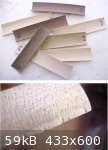
|
|
|
patheslip
Oud Junkie
    
Posts: 160
Registered: 5-24-2008
Location: Welsh Marches
Member Is Offline
Mood: smooth
|
|
On the urine question, the Romans had large jars on town crossroads to collect wee for tanning leather. Don't be shy now.
Seriously, this is a most interesting investigation. Keep up the good work.
|
|
|
Josh
Oud Addict
  
Posts: 32
Registered: 10-7-2008
Location: UK
Member Is Offline
Mood: No Mood
|
|
maybe it was boiling pee.. eek
|
|
|
jdowning
Oud Junkie
    
Posts: 3485
Registered: 8-2-2006
Location: Ontario, Canada
Member Is Offline
Mood: No Mood
|
|
Yea, well when you live in rural farming areas, as I do, you get used to this sort of thing!
The Scots, like the Romans also had communal collecting pots that they would contribute to on their erratic journey home after consuming a few 'malts'
during the course of an evening. Perhaps the liquid intake makes a difference to the final product?
As for the products used for tanning leather by the ancients, urine is only the first step. What follows in the process - although very effective -
gave the leather tanning industry an unpopular reputation in polite society and cast it to the nether regions outside of town and city boundaries -
and banished the employees of this essential industry to pariah status . I won't say what it was but suffice to say I do not intend to go that route
and join the numbers of the great unwashed in modern society - even in the interests of science or whatever!
Today I looked again at the notes that came with the museum drawing of the Dias guitar made by London luthier Stephen Barber.
Barber is convinced that the ribs are made from Kingwood (Dalbergia cearensis) - a member of the rosewood family very similar to Brazilian rosewood
but which, he says, is more elastic and easier to bend than the latter. He informs us that Kingwood comes from a tree of small dimension - 15 to 18 cm
in diameter (6 to 7 inches). This would have been the size of timber generally available to luthiers of the late 16th C with connections to the 'New
World".
The small log size of this timber implies that at least partial slab cut sections of rib stock may have been used?
I have chosen Black Walnut for continuation of these trials because I have some in stock and because it has proven in stage 1 to be easier to bend -
and quicker tp prepare - than Maple (we must learn to crawl before we can walk).
Also, Black Walnut has a similar open cell structure to the true Rosewood genus (see attached macro images Walnut to left - Indian Rosewood to right,
made from samples that I have in stock) - not that the woods are equivalent - but the similar open cell structure should allow for better absorption
of softening fluids for both types of wood? I also have some Brazilian Rosewood lute pegs (made from larger billets purchased in the 1970's) so will
macro photo the grain structure of those for comparison.
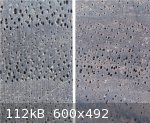
|
|
|
jdowning
Oud Junkie
    
Posts: 3485
Registered: 8-2-2006
Location: Ontario, Canada
Member Is Offline
Mood: No Mood
|
|
For comparison - here is a macro image of one of the lute pegs, mentioned in the previous post, made from Brazilian Rosewood (Jacaranda), Dalbergia
nigra. I should still have the 'off cuts' left over from the peg turning operation - from which I could make images covering a wider area - but I
cannot find them. A better set up for making the macro images needs to be made - with a reference scale to aid comparison - but I haven't got around
to it yet. The diameter of the end of the lute peg is
6 mm. Note that the macro images have to be compressed (reduced in size) for efficient posting on the forum which results in a significant loss of
definition, or clarity, compared to the original images.
The cell size and distribution of Jacaranda is quite similar to another species of rosewood that I have to hand - Cocobolo (or Grenadillo), Dalbergia
retusa.
As Indian Rosewood, Dalbergia latifolia (at least as far as these samples are concerned) seems to have a greater proportion of randomly distributed,
large diameter cells than either Jacaranda or Cocobolo I would guess that it would be quicker to soften and easier to bend - but that is just a theory
at this point in time, yet to be tested.
Note that all of the rosewoods have material - resin and mineral deposits etc. - packed within a proportion of the cells (visible in the macro images)
that may be supporting the cell walls against distortion under compressive loads (experienced during bending). These are 'extractives', which, if they
can be dissolved and removed by the pre-soak marinade fluid - might render the wood more pliable? Just a theory yet to be tested
Once the best marinade and soak time has been determined experimentally for the 'easy' wood - Black Walnut - Indian Rosewood will be next in line for
testing.
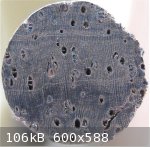
|
|
|
Clayton
Oud Maniac
   
Posts: 52
Registered: 10-24-2008
Location: On the ranch... California
Member Is Offline
Mood: Calm
|
|
What an great investigation... 
I encourage you to continue to both explore the practical methods and to keep us informed of your progress!
I am engrossed!
on a note... not more than obliquely related...
I was told:
...that if you add urea to hide glue, you get a room temperature hide glue... just food for thought and grounds for further research!
|
|
|
jdowning
Oud Junkie
    
Posts: 3485
Registered: 8-2-2006
Location: Ontario, Canada
Member Is Offline
Mood: No Mood
|
|
I hadn't realised before that urea was used to make liquid hide glue or that liquid hide glue was as popular among woodworkers as it seems to be these
days. I made the mistake many years ago of purchasing a half gallon tub of prepared liquid hide glue. As I recall, this stuff was of a rubbery
consistency so still had to be heated before use so I suppose was a bit more convenient to use than glue granules. Anyway, by the time I got around to
using it, the whole lot had decomposed so was useless. Just as well, I suppose, as it is not recommended to use liquid hide glue for instrument
making.
Urea, in white powder form, it seems, is readily available for use as a fertilizer from gardening stores so would be a convenient way to make up into
a marinade. Not sure if the locals will stock it this time of year so that will have to wait until Spring next year.
While phase 2 samples are being marinated, here for information and comparison is a macro of the cell structure of the Cocobolo that I have in stock.
Very similar in structure to Brazilian Rosewood.
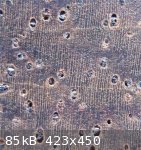
|
|
|
jdowning
Oud Junkie
    
Posts: 3485
Registered: 8-2-2006
Location: Ontario, Canada
Member Is Offline
Mood: No Mood
|
|
..... and, to complete the picture here for comparison is a macro of the cell structure of the maple used in these trials. Unfortunately a reference
scale was not used to enable direct comparison but it can be seen that the maple has smaller cells so absorption of the marinating fluid may be a lot
slower than it might be in wood species with larger cells.

|
|
|
jdowning
Oud Junkie
    
Posts: 3485
Registered: 8-2-2006
Location: Ontario, Canada
Member Is Offline
Mood: No Mood
|
|
Winter has arrived in this part of the world about a month earlier than usual so plans have had to be modified accordingly as temperatures drop
considerably. The phase 2 samples, marinating since 18 November have, therefore, been moved into a warmer location (the kitchen - heated with a wood
stove) so that any bacterial action of the marinades may continue and develop.
Progress was checked today. The phase 2 marinades, with walnut test samples, are:
- Water
- Sake
- Beano
- Household Ammonia solution
- Wood Alcohol.
- 50/50 Glycerine/Wood Alcohol
The Wood Alcohol bag was found to be empty, having leaked, and the sample dry. The sample was, therefore, transferred to a sturdier polythene sealed
box to re-soak.
The fluid in the other sealed bags all showed some colouration indicating that some kind of chemical/bacterial action was in progress. The most
significant colour change is noted in the Beano and Ammonia marinades (with Wood Alcohol at present unknown) - the fluids having a deep brown
colouration.
The depth of colour of the marinade may be useful in future as a guide to judge optimum time of immersion.
At the same time, the phase 1 samples were checked dimensionally to determine their stability after initial drying after bending. Samples #1 to #6
showed a measured increase in longitudinal radius of 12% to 18 % with no significant change in the radius of the fluting. Sample #7 showed no change
in either dimension so is considered stable. Sample #8 showed a 7 % increase in longitudinal radius. The stable dimensions of sample #7 may be due
either to the marinating fluid or immersion period (which was longer than for the other test samples) or to the wood species (Walnut versus Maple).
The phase 2 samples will be tested for bending in about a week i.e. after about a month marinating.
|
|
|
jdowning
Oud Junkie
    
Posts: 3485
Registered: 8-2-2006
Location: Ontario, Canada
Member Is Offline
Mood: No Mood
|
|
Phase 2 bending started today, the samples having marinated for about a month.
Sample #9 Walnut in Sake - marinated for 28 days. The marinating fluid had a light brown tinge to it and the sample was quite flexible when cold. It
had curved slightly across its width and - in the same direction - along its length. The sample was boiled in water for 5 minutes and then tied to the
mold as for the Phase 1 samples. The sample was placed on the mold with the curvature across its width following the curvature of the mold (i.e. the
curve of the fluting).
The sample split at both ends as it was being tied to the mold - the most severe of the splits being 4 cm (1- 5/8 inches) long.
So this is considered to be a failure unlike sample #1 (walnut in sake, phase 1 tests) that bent without splitting after only 4 days marinating.
Sample #1 is quarter sawn, sample #9 is part slab sawn which might be part of the problem
For Phase 2 tests, I am using an elastic (stretchy) fabric tape (ice hockey boot laces - cheap, strong, wide and long) instead of string which cuts
into the softened wood. The wide tape distributes the pressure more uniformly so should reduce the tendency of a sample to split. Not in this case,
however!
The sample will be left overnight to dry and sample #10 will be bent tomorrow - hopefully with better results.

|
|
|
jdowning
Oud Junkie
    
Posts: 3485
Registered: 8-2-2006
Location: Ontario, Canada
Member Is Offline
Mood: No Mood
|
|
Sample #10 - Walnut in Beano, marinating 29 days. Marinating fluid dark brown. Sample coated with a slime.
After boiling in fresh water for 5 minutes the sample was tied to the mold. It cracked at one end - crack 3mm long.
|
|
|
| Pages:
1
2
3
4
5 |